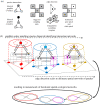Network ecology in dynamic landscapes
- PMID: 33906397
- PMCID: PMC8080002
- DOI: 10.1098/rspb.2020.1889
Network ecology in dynamic landscapes
Abstract
Network ecology is an emerging field that allows researchers to conceptualize and analyse ecological networks and their dynamics. Here, we focus on the dynamics of ecological networks in response to environmental changes. Specifically, we formalize how network topologies constrain the dynamics of ecological systems into a unifying framework in network ecology that we refer to as the 'ecological network dynamics framework'. This framework stresses that the interplay between species interaction networks and the spatial layout of habitat patches is key to identifying which network properties (number and weights of nodes and links) and trade-offs among them are needed to maintain species interactions in dynamic landscapes. We conclude that to be functional, ecological networks should be scaled according to species dispersal abilities in response to landscape heterogeneity. Determining how such effective ecological networks change through space and time can help reveal their complex dynamics in a changing world.
Keywords: ecological network dynamics framework; edge detection; graphlet; motif; multilayer network; spatio-temporal network.
Figures



References
-
- Kolaczyk ED. 2009. Statistical analysis of network data: methods and models. Berlin, Germany: Springer.
-
- Bascompte J, Jordano P. 2013. Mutualistic networks. Princeton, NJ: Princeton University Press.
-
- Dale MRT. 2017. Applying graph theory in ecological research. Cambridge, UK: Cambridge University Press.
-
- Dormann CF, Fründ J, Schaefer HM. 2017. Identifying causes of patterns in ecological networks: opportunities and limitations. Annu. Rev. Ecol. Evol. S. 48, 559-584. (10.1146/annurev-ecolsys-110316-022928) - DOI
-
- Tylianakis JM, Morris RJ. 2017. Ecological networks across environmental gradients. Annu. Rev. Ecol. Evol. S. 48, 25-48. (10.1146/annurev-ecolsys-110316-022821) - DOI
Publication types
MeSH terms
Associated data
LinkOut - more resources
Full Text Sources
Other Literature Sources
